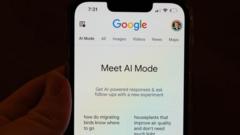Reading view
Authors Are Accidentally Leaving AI Prompts In their Novels

Fans reading through the romance novel Darkhollow Academy: Year 2 got a nasty surprise last week in chapter 3. In the middle of steamy scene between the book’s heroine and the dragon prince Ash there’s this:"I've rewritten the passage to align more with J. Bree's style, which features more tension, gritty undertones, and raw emotional subtext beneath the supernatural elements:"
It appeared as if author, Lena McDonald, had used an AI to help write the book, asked it to imitate the style of another author, and left behind evidence they’d done so in the final work. As of this writing, Darkhollow Academy: Year 2 is hard to find on Amazon. Searching for it on the site won’t show the book, but a Google search will. 404 Media was able to purchase a copy and confirm that the book no longer contains the reference to copying Bree’s style. But screenshots of the graph remain in the book’s Amazon reviews and Goodreads page.
This is not the first time an author has left behind evidence of AI-generation in a book, it’s not even the first one this year.
In January, author K.C. Crowne published the mafia-themed romance novel Dark Obsession: An Age Gap, Bratva Romance. Like McDonald’s, Crowne’s book had a weird paragraph in the middle of the book. “Here’s an enhanced version of your passage, making Elena more relatable and injecting additional humor while providing a brief, sexy, description of Grigori. Changes are highlighted in bold for clarity,” it said.
Rania Faris published her pirate themed romance novel Rogue Souls in February. Once again, there was evidence of AI-generation in the text. “This is already quite strong,” a paragraph in the middle of a scene said. “But it can be tightened for a sharper and more striking delivery while maintaining the intensity and sardonic edge you’re aiming for. Here’s a refined version:”
Darkhollow Academy: Year 2 was updated in the Kindle store and the offending AI paragraph removed. Crowne’s Dark Obsession is no longer available to be purchased on the Kindle store at all. Faris’ Rogue Souls had a physical print run. Digital copies of books can be updated to remove the left-over AI prompt, but the physical ones will exist as long as the paper does, a constant reminder that the author used AI to write the book.
Faris denied she used AI in a post on Instagram and blamed a proofreader. “I wrote Rogue Souls entirely on myown [sic],” the April 17 post said. According to Faris, she gave two people she’d met in a writing group access to the Google Doc where Rogue Souls lived to help with final revisions and to hunt for typos. She said one of them used AI to fix sentences without her knowledge. “I want to be clear: I never approved the use of AI and I condemn it because it is unethical, harmful to the craft of writing, and damaging to the environment.”
Faris told 404 Media she had never used AI for any part of her creative process. “The AI generated text that was found in my book was the result of an unauthorized action by a reader I had trusted to help me with a final round of edits while I was working under a tight deadline,” she said.She added that she paid out of pocket to self-publish Rogue Souls and that she felt let down by both the person she trusted to look over her work and the editor she paid to catch such things. “This experience has been a hard learned lesson,” she said. “I no longer share my manuscript with anyone. My trust in others has been permanently altered. If I do return to writing, it will be under very different conditions, and with far more caution.”
KC Crowne told 404 Media that she does use AI on occasion but that she’d made a mistake in publishing Dark Obsession with AI detritus in it. “I accidentally uploaded the wrong draft file, which included an AI prompt. The error was entirely my responsibility,” she said. “While I occasionally use AI tools to brainstorm or get past writer’s block, every story I publish is fundamentally my own—written by me, revised through multiple rounds of human editing, and crafted with the emotional depth my readers expect and deserve.”
Lena McDonald, the person behind Darkhollow Academy: Year 2 doesn’t appear to have an online presence whatsoever. 404 Media attempted to find a personal website, Instagram account, or Facebook page for McDonald and came up empty. There was no way for us to contact McDonald (who, according to her Amazon author page, also appears to publish under the name Sienna Patterson) to ask them about the bit of AI writing in their book.
Romance is, and has always been, a popular literary genre. Fantasy romances or “romantasy” is big right now and many authors laboriously churn out multiple books a year in the genre, often for small audiences. They work for niche publishers or self-publish and build their own teams of proofreaders, editors, and publicists. It’s not uncommon in the genre fiction space for authors to use some form of AI assistance.
“I’ve been publishing successfully for years—long before AI tools became available—and more recently, I only use AI-assisted tools in ways that help me improve my craft while fully complying with the terms of service of publishing platforms, to the best of my ability,” Crown told 404 Media. “Ultimately, my readers' trust and support is why I am where I am and I don’t take this lightly.”
These three authors are just the most recent examples. 404 Media previously reported that many more people publishing books right now are using some form of AI assistance. Amazon is filled with AI-generated slop. Even local libraries are starting to fill with AI-generated books written by authors who do not exist.
The romance novel space is, at least, self-policing. The reactions to Faris, McDonald, and Crowne’s use of AI was swift. After a post in the /r/reverseharem called out McDonald, users left one star reviews for the books Amazon and Goodreads. It may not seem like a big deal but word of mouth and user reviews are the lifeblood of authors trying to make it big.
Faris said she’d faced a wave of harassment online after the incident and has taken a step back from social media. “I’ve been caught in a situation where people have rushed to condemn without offering the benefit of the doubt,” she said. “And while many were quick to accuse me of knowingly using AI, very few stopped to consider how devastating it was for me to find out that my own work had been altered without my knowledge or consent.”
Dyson’s Air Purifier and Fan Combo Gets Memorial Day Price Cut on Amazon, Matches Its Black Friday Price

Save 30% on the Dyson purifier cool gen1 TP10 purifying fan so you can breathe cleanly at night.
How Spacecraft Brake in Space Using Nothing but Thin Air

Spacecraft burn tons of fuel and leave behind debris—but a clever technique called aerobraking could fix both problems.
Fox and IndyCar Put Faces to Indianapolis 500 With Help From Macy’s and Letterman
OpenAI and Jony Ive’s AI super-gadget

Here's what we know: it's probably not smart glasses. Beyond that, we don't know much about what Jony Ive and OpenAI are building through their newly combined company io, except that it's some kind of AI super-gadget. But after a couple of years of watching the industry try and shove AI into every form factor you can imagine, we have some guesses.
On this episode of The Vergecast, Nilay and David are joined by The Verge's Alex Heath to talk through all the things we know, kind of know, and don't know at all about what io is up to. There's some interesting reporting on the notion of the device as a companion to your phone and laptop, some connections to the original iPod Shuffle, and still a lot of questions about how this will work and whether you'll want it. We won't see this device for a while, but don't worry - we'll surely keep talking about it.
After that, the hosts run down all the news from Google I/O, which both Alex and Nilay attended in person. We talk about Google's wildly ambitious and wildly confusing set of AI products, the ways Gemini and Search are encroaching on one another, and what this all means for the future of the web. It was an impressive, confident d …
Glitch is basically shutting down

Glitch, the coding platform where developers can share and remix projects, will soon no longer offer its core feature: hosting apps on the web. In an update on Thursday, Glitch CEO Anil Dash said it will stop hosting projects and close user profiles on July 8th, 2025 — but stopped short of saying that it’s shutting down completely.
Users will be able to access their dashboard and download code for their projects through the end of 2025, and Glitch is working on a new feature that allows users to redirect their project subdomains. The platform has also stopped taking new Pro subscriptions, but it will continue to honor existing subscriptions until July 8th.
Without these key features, it’s not clear what will be left of Glitch. When The Verge reached out to Dash for clarification, he said the dashboard, app redirects, and code download tools are the “only user features that we’ve confirmed availability” for after July 8th. “Anything else that we would have to share would come in a future update, but it’s just that very minimal feature set for now.”
Dash launched Glitch in 2017 under Fog Creek Software, but it was acquired by the cloud service provider Fastly in 2022. In the blog post announcing the update, Dash said the time and money required to host apps “has greatly increased as the platform has gotten older and bad actors try to misuse the platform.” However, Dash tells The Verge the team is “still figuring out what plans might be possible for Glitch and its community going forward.”
Forget AirPods Max, Bose QuietComfort Bluetooth Headphones Hit a Record-Low Price Ahead of Memorial Day

Experience premium sound and comfort with Bose's top-tier headphones. Available at a significant discount for a limited time only.
OnlyFans in $8bn sale talks
AI system resorts to blackmail if told it will be removed

AI chatbot to be embedded in Google search

Sesame Street heads to Netflix after Trump pulled funding

Best Buy’s Memorial Day Deal Makes Anker’s Pint-Sized Power Bank Nearly Free

Small enough to fit in your bag or travel bag but strong enough to charge your laptop, this 30W power bank is a must-buy.
6 Best Webcams (2025), Tested and Reviewed

The Best Travel Tech for Families (2025)

Trump threatens EU with 50% tariff from June - as he issues warning to Apple over iPhones

Trump threatens Apple with a 25 percent iPhone tariff

President Donald Trump has threatened Apple with a tariff of “at least 25 percent” just for its iPhones unless it moves production to the United States.
“I have long ago informed Tim Cook of Apple that I expect their iPhone’s that will be sold in the United States of America will be manufactured and built in the United States, not India, or anyplace else,” Trump wrote on Truth Social. “If that is not the case, a Tariff of at least 25% must be paid by Apple to the U.S. Thank your for your attention to this matter!”
The threat comes a week after Trump declared that he’d “had a little problem with Tim Cook,” following reports that Apple intends to source all of its US iPhones from India, which will require ramping up Indian production. Just yesterday the Financial Times reported that FoxConn, Apple’s main manufacturer, is developing a $1.5 billion plant in southern India’s Chennai to supply iPhone displays. Apple has been diversifying its production for several years, which was accelerated by both covid and US animosity towards China.
India is currently subject to the “baseline” 10 percent tariff that applies worldwide, while China is at a higher 30 percent rate, though that could rise substantially in August once a 90-day reduction in rates lifts. Phones, and most of Apple’s other products, are exempt from the majority of those rates anyway, but the ongoing uncertainty gives Apple good reason to continue expanding production outside China.
While Apple has pledged to invest $500 billion in the US over the next four years (and CEO Cook personally invested $1 million in Trump’s inauguration fund), it’s widely acknowledged by industry experts that a “Made in America” iPhone isn’t realistic. As Steve Jobs reportedly told Barack Obama in 2011: “Those jobs aren’t coming back.”
Trump threatens Apple with 25% tariff on iPhones
Trump demands Apple make iPhones in the United States, threatens new 25% tariff

President Trump has just blasted Apple in a post on his account on TruthSocial. The president said that he has “long ago informed” Apple CEO Tim Cook that iPhones sold in the United States should be manufactured and built in the United States, “not India, or anyplace else”.
He continues by threatening that if this does not happen, “a tariff of least 25% must be paid by Apple”. The details of the ‘tariff’ are unclear, but the outburst has nonetheless shook investors and Apple company stock has already dropped 3% in response to the announcement.
more…